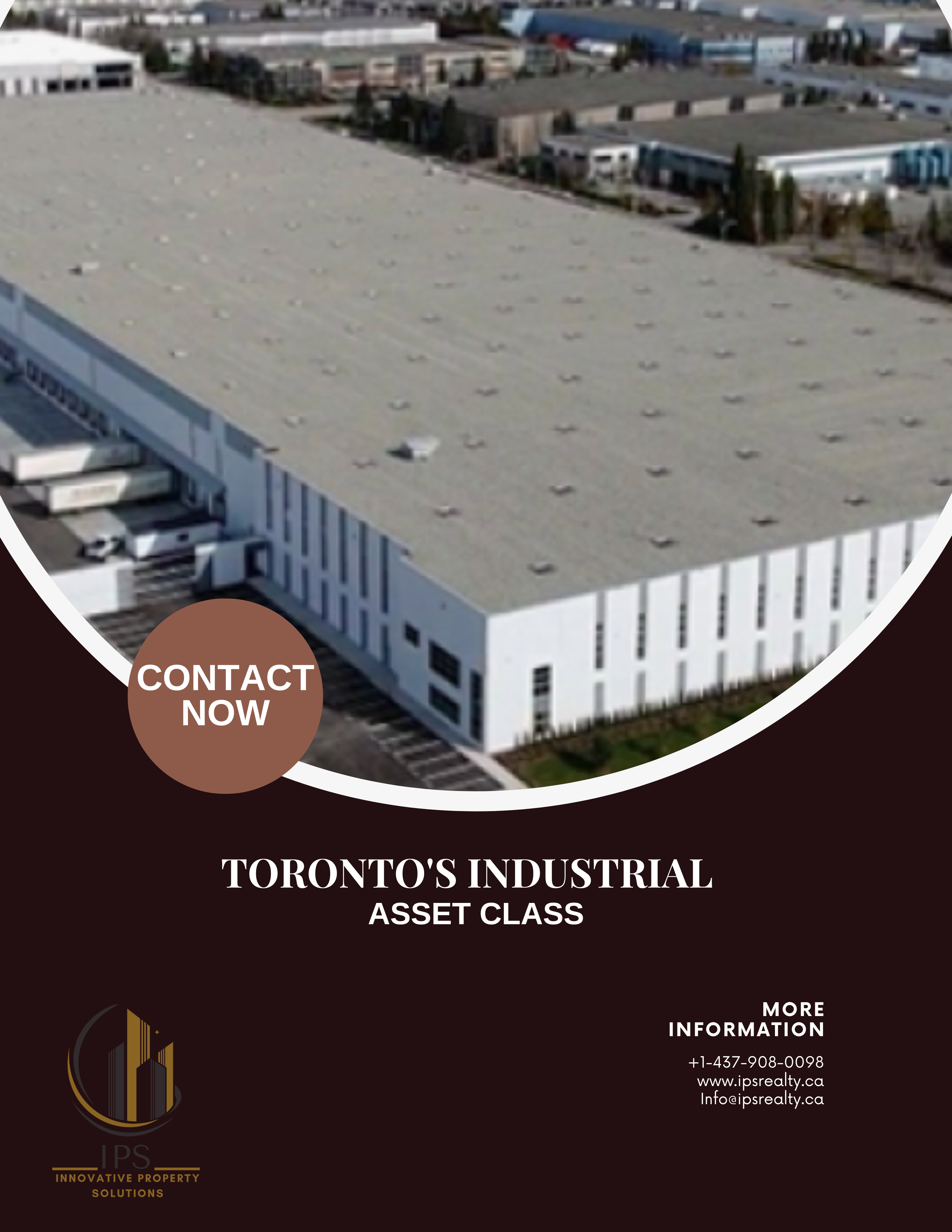
The Greater Toronto Area (GTA) industrial real estate market has experienced significant transformation driven by e-commerce growth, shifting supply chain demands, and changing investment dynamics. This report analyzes the current state of Toronto’s industrial sector, examining valuation challenges, market fundamentals, and future growth prospects as the market enters a period of rebalancing following years of unprecedented expansion.
The E-Commerce and Logistics-Driven Industrial Boom
The GTA’s industrial property market has witnessed remarkable growth primarily fueled by sustained demand for e-commerce and logistics facilities. Major technology companies have played pivotal roles in this expansion, with Shopify announcing plans to double its Toronto workforce to 1,500 employees and develop a 3.2-hectare mixed-use centre in the downtown core. This expansion forms part of Shopify’s strategy to establish a network of fulfillment warehouses to compete directly with Amazon’s dominance in the e-commerce space1.
The industrial boom has been characterized by unprecedented construction activity. By late 2019, projections indicated the addition of nearly 4.4 million square feet of industrial space in the region1. This development pace has accelerated in recent years, with year-end deliveries exceeding 18.9 million square feet by late 2024, surpassing the five-year average by approximately 7.2 million square feet6.
Beyond e-commerce, Toronto’s status as a global tech destination has also contributed significantly to industrial demand. An open immigration policy and mature tech ecosystem have attracted national and international firms looking to expand their workforce in Toronto, leading to some of the lowest vacancy rates in North America during the market’s peak1.
Demand Drivers Behind the Industrial Surge
Several factors continue to drive demand for industrial real estate in Toronto:
- E-commerce Expansion: The most significant demand comes from e-commerce, logistics, and manufacturing operations requiring substantial working and distribution spaces2.
- Cost-Effective Operations: Industrial properties offer economically superior maintenance compared to other real estate forms, with designs focused on durability and functionality that minimize ongoing costs2.
- Strategic Location Requirements: Properties with quick access to major transportation arteries like Highways 401, 407, and the DVP command premium valuations due to their logistical advantages34.
Market Dynamics and Current Conditions
After years of extremely tight market conditions, the Toronto industrial landscape is undergoing a significant rebalancing. Vacancy rates have increased for nine consecutive quarters, reaching a five-year high of 3.1% by the end of 2024—a 160-basis-point increase compared to the previous year6. This shift from the historic low of 0.6% in Q2 2022 represents a substantial change in market dynamics5.
Supply Pipeline Contraction
Despite rising vacancy, the market appears to be responding to changing conditions through self-correction mechanisms. The construction pipeline has contracted dramatically, reducing by over 58.5% compared to the previous year. Only 9.4 million square feet remain under development, placing the current pipeline below the five-year average of 14.7 million square feet6. This contraction signals the conclusion of the pandemic-era construction boom and suggests developers are exercising greater caution.
The segment experiencing the largest increase in available listings is buildings over 200,000 square feet, which is particularly significant since this represents the predominant building type expected to be delivered in the coming years4. Industry experts note that constructing buildings below 20,000 square feet is economically unviable unless developed as industrial condominiums4.
Sublet Space Dynamics
A notable trend in the current market is the increasing availability of sublet space, particularly in Class-A industrial buildings exceeding 50,000 square feet. Over two million square feet of sublet space is now available, with geographic distribution heavily concentrated in specific submarkets4:
- Brampton: 45% of available sublet space
- Vaughan: 29%
- Caledon: 12%
- Toronto: 9%
- Mississauga: 5%
Amazon alone accounts for approximately 745,515 square feet of available sublet space, comprising one-third of the total market. This reflects Amazon’s strategic adjustment following rapid expansion during the COVID-19 pandemic to accommodate surging e-commerce demand4.
Rental Growth Patterns and Valuation Implications
Rental rate growth has undergone significant moderation after a period of extraordinary increases. During the peak period from Q4 2021 to Q3 2022, rents increased at an annualized rate of 37.6%4. Since then, growth has slowed considerably to an annualized rate of 10.4%, with average industrial rents now standing at $18.57 per square foot4.
Shifting Growth Projections
The market has experienced a pronounced shift in rental growth expectations, transitioning from annual growth rates of approximately 20% to rates more closely aligned with inflation5. This deceleration in rental growth is gradually influencing property valuations across the industrial sector. While the query references an expected annual rental growth of 5-7%, the search results suggest current growth rates may be moderating to levels consistent with broader economic indicators.
Valuation Challenges in a Dynamic Market
Appraisers and investors face several challenges in accurately valuing industrial properties in the current market environment:
Interest Rate Impact
Rising interest rates have had a significant and direct impact on commercial real estate, affecting even the resilient GTA industrial market. The market consensus suggests interest rates have stabilized, potentially indicating the bottom of the current market cycle5. However, slowing rental rate projections—a primary driver of industrial valuations—are working through the valuation process, potentially positioning the GTA industrial market closer to the middle of its market cycle5.
Transaction Challenges
Two common obstacles to completing transactions in the current environment are shifting market conditions (particularly interest rates) and concerns arising during due diligence processes. Industry experts recommend accelerating transaction timelines through thorough pre-marketing due diligence, including review of leases, environmental assessments, building condition reports, and operating statements before engaging potential buyers5.
Persistent Investor Demand
Despite market shifts, industrial investment has historically been characterized by undersupply, with buyer demand exceeding seller availability. This dynamic persists in the current market, with real estate investors generally maintaining a bullish long-term outlook on the GTA’s industrial investment market5.
Geographic Value Concentrations
Location remains a critical factor in industrial property valuation, with highway proximity commanding significant premiums. Properties with quick access to major transportation routes like Highway 401, Highway 407, and the DVP feature prominently in listing highlights3. The strategic value of these locations derives from their logistical advantages for distribution operations requiring efficient regional connectivity.
Submarkets like Brampton—which accounts for 45% of available sublet space—represent particular valuation challenges as appraisers must balance current availability increases against long-term strategic value4. The concentration of industrial activity in specific corridors creates micro-markets with distinct valuation profiles that may diverge from broader market trends.
Conclusion
The Toronto industrial real estate market stands at an inflection point after years of exceptional growth. While demand fundamentals remain strong—driven by e-commerce, logistics, and manufacturing requirements—the market is experiencing a necessary rebalancing as construction pipelines contract and vacancy rates increase from historic lows.
Valuation challenges persist as appraisers navigate competing forces: moderating rental growth and rising interest rates against strong long-term demand fundamentals and strategic location premiums. The current environment requires sophisticated analysis that balances cost inflation considerations against future income potential, particularly for properties in prime locations with highway access.
As the market continues its rebalancing process, strategic opportunities remain for investors with longer time horizons who can capitalize on location advantages while navigating the current period of moderation. The underlying strength of Toronto’s industrial market continues to attract investor interest despite near-term adjustments, reflecting confidence in the sector’s long-term fundamentals.
Citations:
- https://www.rentexrealty.com/blog/dynamism-in-gta-industrials-segment-fuelled-by-e-commerce-logistics-2350
- https://allenmayer.ca/why-is-torontos-demand-for-industrial-real-estate-growing/
- https://cbci.ca/idx/commercial/industrial/forsale/toronto
- https://renx.ca/greater-toronto-industrial-real-estate-vacancy-rent-increases
- https://renx.ca/an-expert-look-at-investing-in-torontos-industrial-market
- https://www.savills.ca/research_articles/261115/371716-0
- https://retail-insider.com/retail-insider/2022/01/explosion-in-e-commerce-results-in-concerning-shortage-of-supply-of-vital-industrial-space-experts/
- https://www.warehousing-toronto.com/blog/the-vital-role-of-warehousing-in-toronto-s-supply-chain-economy
- https://www.zolo.ca/toronto-real-estate/401-magnetic-drive/10-11
- https://www.cbre.ca/insights/articles/toronto-real-estate-outlook-2025
- https://www.cbre.ca/-/media/project/cbre/shared-site/canada-emerald/offices/toronto-west/gary-taylor/brampton-industrial-market-snapshot-q3-2022.pdf
- https://www.cbre.ca/insights/figures/toronto-industrial-figures-q4-2024
- https://ipsrealty.ca/toronto-industrial-real-estate-tariff-impact/
- https://renx.ca/gta-industrial-real-estate-market-is-transitioning
- https://canada.constructconnect.com/dcn/news/economic/2024/07/brampton-deals-top-gta-industrial-real-estate-activity-in-q2
- https://www150.statcan.gc.ca/n1/daily-quotidien/240528/dq240528a-eng.htm
- https://tradelinkinternational.ca/e-commerce-drives-canadas-warehouse-boom/
- https://instorage.com/2024/05/02/navigating-torontos-warehouse-boom-trends-and-insights/
- https://www.realtor.ca/on/milton/401-business-park/commercial-real-estate
- https://www.nmrk.com/storage-nmrk/uploads/fields/pdf-market-reports/3Q24-Toronto-Industrial-Report_2024-10-30-230228_msgn.pdf
- https://www.consulting.ca/news/4278/lower-interest-rates-driving-industrial-real-estate-acquisition-in-canada
- https://www.goranbrelih.com/the-impact-of-e-commerce-on-the-gtha-industrial-real-estate-market/
- https://vidtech.com/blog/toronto-2025-industrial-big-box-market-outlook/
- https://www.collierscanada.com/en-ca/properties/move-in-ready-industrial-space-with-premium-upgrades-at-consumers-square-available-for-sale/can-280-422-consumers-road-unit-19-toronto-on/can2016602
- https://www.collierscanada.com/en-ca/research/toronto-industrial-market-report-2024-q4
- https://cme-mec.ca/wp-content/uploads/2024/01/Manufacturing-Ontarios-Future.pdf
- https://www150.statcan.gc.ca/n1/daily-quotidien/250220/dq250220a-eng.htm
- https://mediaassets.cbre.com/-/media/project/cbre/shared-site/teams/canada/toronto-west/john-planeta/q4-report-toronto-west-industrial-market-report.pdf?rev=d9292d2c199d437fbf23e7341ff1dd22
- https://lumicre.com/realestate/investment-opportunities-in-torontos-tight-industrial-market/
- https://www.avisonyoung.ca/documents/d/toronto-gta/gta-industrial-market-report-q2-2024-
- https://www.goranbrelih.com/will-industrial-rents-soar-in-2024-or-will-pricing-adjust-or-go-bust-2/
- https://www.jll.ca/en/trends-and-insights/research/toronto-industrial-insight
- https://www.altusgroup.com/insights/toronto-commercial-real-estate-market-update/
- https://www.collierscanada.com/download-article?itemId=fd64995c-8b88-4405-b6f7-d03ccab954ce
- https://www.ogrealtygroup.ca/how-to-invest-in-toronto-industrial-real-estate/
- https://www.goranbrelih.com/gta-industrial-2024-state-of-the-market/


